How cheap can you make a phone?
Recently, I paid $12 at Mingtong Digital Mall for a complete phone, featuring quad-band GSM, Bluetooth, MP3 playback, and an OLED display plus keypad for the UI. Simple, but functional; nothing compared to a smartphone, but useful if you’re going out and worried about getting your primary phone wet or stolen.
Also, it would certainly find an appreciative audience in impoverished and developing nations.
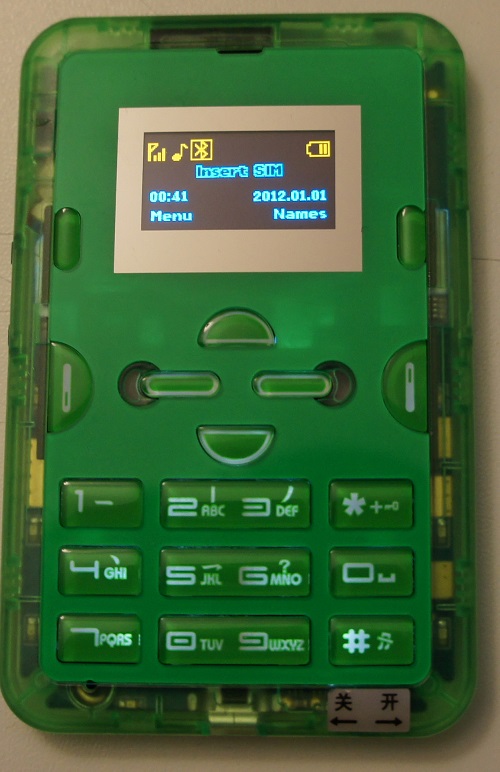
$12 is the price paid for a single quantity retail, contract-free, non-promotional, unlocked phone — in a box with charger, protective silicone sleeve, and cable. In other words, the production cost of this phone is somewhere below the retail price of $12. Rumors place it below $10.
This is a really amazing price point. That’s about the price of a large Domino’s cheese pizza, or a decent glass of wine in a restaurant. Or, compared to an Arduino Uno (admittedly a little unfair, but humor me):
| Spec | This phone | Arduino Uno |
|---|---|---|
| Price | $12 | $29 |
| CPU speed | 260 MHz, 32-bit | 16 MHz, 8-bit |
| RAM | 8MiB | 2.5kiB |
| Interfaces | USB, microSD, SIM | USB |
| Wireless | Quadband GSM, Bluetooth | – |
| Power | Li-Poly battery, includes adapter | External, no adapter |
| Display | Two-color OLED | – |
How is this possible? I don’t have the answers, but it’s something I’m trying to learn. A teardown yields a few hints.
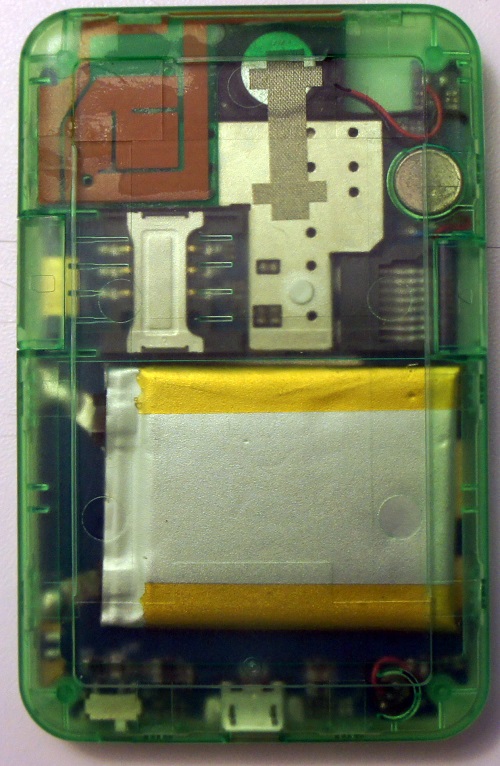
First, there are no screws. The whole case snaps together.
Also, there are (almost) no connectors on the inside. Everything from the display to the battery is soldered directly to the board; for shipping and storage, you get to flip a switch to hard-disconnect the battery. And, as best as I can tell, the battery also has no secondary protection circuit.
The Bluetooth antenna is nothing more than a small length of wire, seen on the lower left below.
Still, the phone features accoutrements such as a back-lit keypad and decorative lights around the edge.
The electronics consists of just two major ICs: the Mediatek MT6250DA, and a Vanchip VC5276. Of course, with price competition like this, Western firms are suing to protect ground: Vanchip is in a bit of a legal tussle with RF Micro, and Mediatek has also been subject to a few lawsuits of its own.
The MT6250 is rumored to sell in volume for under $2. I was able to anecdotally confirm the price by buying a couple of pieces on cut-tape from a retail broker for about $2.10 each. [No, I will not broker these chips or this phone for you…]
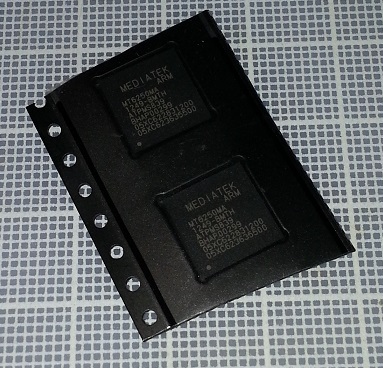
That beats the best price I’ve ever been able to get on an ATMega of the types used in an Arduino.
Of course, you can’t just call up Mediatek and buy these; and it’s extremely difficult to engage with them “going through the front door” to do a design. Don’t even bother; they won’t return your calls.
However, if you know a bit of Chinese, and know the right websites to go to, you can download schematics, board layouts, and software utilities for something rather similar to this phone…”for free”. I could, in theory, at this point attempt to build a version of this phone for myself, with minimal cash investment. It feels like open-source, but it’s not: it’s a different kind of open ecosystem.
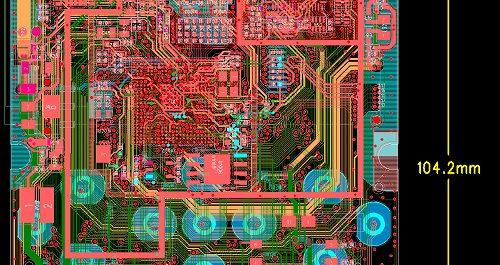
Introducing Gongkai
Welcome to the Galapagos of Chinese “open” source. I call it “gongkai” (公开). Gongkai is the transliteration of “open” as applied to “open source”. I feel it deserves a term of its own, as the phenomenon has grown beyond the so-called “shanzhai” (山寨) and is becoming a self-sustaining innovation ecosystem of its own.
Just as the Galapagos Islands is a unique biological ecosystem evolved in the absence of continental species, gongkai is a unique innovation ecosystem evolved with little western influence, thanks to political, language, and cultural isolation.
Of course, just as the Galapagos was seeded by hardy species that found their way to the islands, gongkai was also seeded by hardy ideas that came from the west. These ideas fell on the fertile minds of the Pearl River delta, took root, and are evolving. Significantly, gongkai isn’t a totally lawless free-for-all. It’s a network of ideas, spread peer-to-peer, with certain rules to enforce sharing and to prevent leeching. It’s very different from Western IP concepts, but I’m trying to have an open mind about it.
I’m curious to study this new gongkai ecosystem. For sure, there will be critics who adhere to the tenets of Western IP law that will summarily reject the notion of alternate systems that can nourish innovation and entrepreneurship. On the other hand, it’s these tenets that lock open hardware into technology several generations old, as we wait for patents to expire and NDAs to lift before gaining access to the latest greatest technology. After all, 20 years is an eternity in high tech.
I hope there will be a few open-minded individuals who can accept an exploration of the gongkai Galapagos. Perhaps someday we can understand — and maybe even learn from — the ecosystem that produced the miracle of the $12 gongkai phone.
Tags: gongkai, mediatek, twelve dollar phone
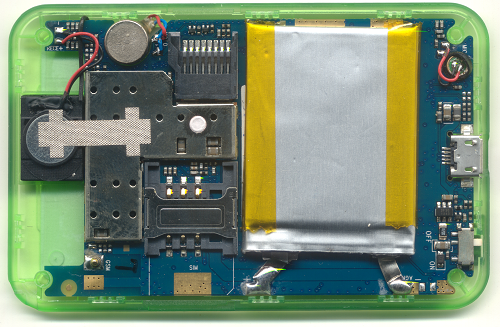
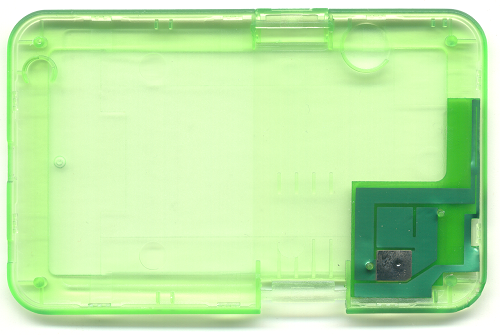
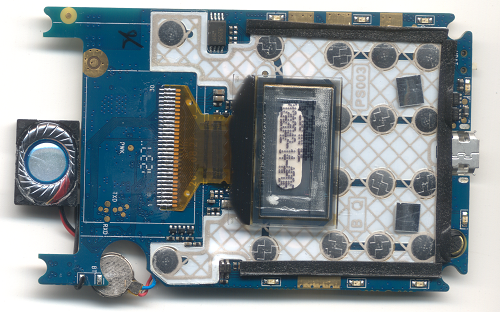
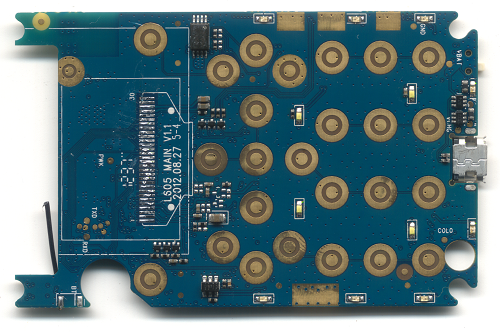
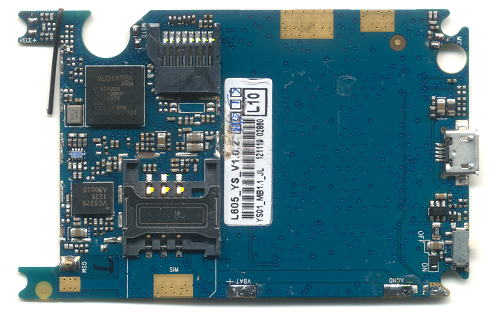
Sparse but very helpful silk screen. That TXD/RXD just demands to be hooked up to a Bus Pirate :)
I wonder how cheaply they could do a “protest” phone. Same minimal specs except add a camera and enough of a data connection to push pictures into the cloud. (Minimal local storage)
Went to an anti-CSPAA rally last Saturday, and was torn between bringing a data filled phone, and not having a way to take and send pictures, if I left it home. A $25 phone/camera that could be confiscated without the authorities able to get access to private info that grabbing a smart phone would gone them. The photo push to cloud is why I wouldn’t just supplement the phone above with a standalone, comparably cheap camera.
Digital camera + Eye-Fi + 3G hotspot?
Part of the idea for a no-frills camera phone, at a price point comparable to Bunnie’s discovery, is to get a one piece minimum-needed device, that if officer unfriendly “accidentally” grinds to the curb, I can just shrug, having lost nothing of real value, and with the data already beyond reach of deletion.
If you can find a $20 hotspot, you could combine that with a cheapo web surveillance camera, with built-in wifi. Crappier than your solution, (but likely good enough) and with quality about what I would expect to be in the disposable price point camera phone.
You went to an ANTI-CSPAA rally? So you are AGAINST a law that outlaws child soldiers? What are you thinking? Guess you must agree with Obama that child soldiers are GOOD.
On October 3, 2008, President George W. Bush signed into law “Child Soldiers Prevention Act of 2008,” a law that made it a federal crime to recruit or use soldiers under the age of 15. The law also gave the United States authority to “prosecute, deport or deny entry to individuals who have knowingly recruited children as soldiers.”
The bipartisan law, which was passed unanimously by both houses of Congress, drew the applause of several international human rights organizations:
“The US is saying to the world that using child soldiers is a serious crime and that it will take action,” said Jo Becker, children’s rights advocate for Human Rights Watch. “Military commanders who use children can no longer come to the United States without the risk of ending up in jail.”
Over the weekend, while most Americans were too busy spending time with their children and keeping up with the latest sporting events to worry about executive orders, PRESIDENT OBAMA REMOVED THE TEETH FROM THIS LAW; effectively making it void in the nations most guilty. The result – thousands of children throughout the Middle East and Africa may be drafted into foreign militaries, with the full blessings of the United States.
Sunday afternoon, President Obama signed a Presidential memorandum, stating the following:
“I hereby determine that it is in the national interest of the United States to waive the application of the prohibition in section 404(a) of the CSPA [Child Soldiers Prevention Act of 2008] with respect to Libya, South Sudan, and Yemen… and the issuance of licenses for direct commercial sales of U.S. origin defense articles; and I hereby waive such provisions accordingly.”
What are you on about? This is realpolitik, plain and simple. The countries that recruit child soldiers are not going to stop doing so, and pretending that they don’t exist isn’t going to help change anything.
South Sudan, Yemen, Libya, the Democratic Republic of the Congo; one thing in common with all of these countries is that they are currently in a state of political turmoil (border clashes in South Sudan, the recent ousting of a dictator in Yemen, the ongoing civil war in the DRC).
America needs to get involved in these, perhaps not by sending troops, but by sending military aid. Which is what they’re doing, contrary to your slanted reportage. I quote:
“I hereby determine that it is in the national interest of the United States to waive the application of the prohibition in section 404(a) of the CSPA with respect to Libya, South Sudan, and Yemen…”
So, no mention of selling weapons to these countries. The part about the “issuance of licenses for direct commercial sales of U.S. origin defense articles” applies ONLY to the DRC:
“…and further determine that it is in the national interest of the United States to waive in part the application of the prohibition in section 404(a) of the CSPA with respect to the Democratic Republic of the Congo, TO ALLOW FOR CONTINUED PROVISION OF INTERNATIONAL MILITARY EDUCATION AND TRAINING FUNDS AND NONLETHAL EXCESS DEFENSE ARTICLES, AND THE ISSUANCE OF LICENSES FOR DIRECT COMMERCIAL SALES OF U.S. ORIGIN DEFENSE ARTICLES; and I hereby waive such provisions accordingly.”
Military education. Training funds. NON-lethal defense articles. Does this sound like “we’re shipping weapons to arm child soldiers” to you?
Open your mind to viewpoints that aren’t yours, and to what words are ACTUALLY saying. You’ll learn more.
(Also, yes, I know that you’re making a joke about the confusion between CISPA and CSPA. I’m just adding to it Andy Kaufman-like.)
I’ve been confronted with a ‘child soldiers’ and they will shoot you. I was almost court martialed in the U.S. Army for not firing back. I instead ordered my linguist to have them surrender. As we had them in an ambush position they fired a few shots and ran way. They ended up attacking and killing 2 other U.S. Soldiers. There is no laws on the battlefield but one, survive.
Only in western countries are soldiers familiar with chivalry, if they read the right books, and they are few and far between.
Reality? Hahahahahahaha. With no truth, there is no reality.
Странно, дори и при вас всяка технологична новина може да се превърне в безкрайно политическо бла-бла :(
Different act… The rally I went to concerned the computer fraud act that was used to prosecute Aaron Swartz.
I bought a Huawei phone in a (expensive) retail store, no contract, for the equivalent of ~22$ in europe. It has a 2mp camera, 3g, GPS (although that really takes a while to sync), 256mb ram, and Android 2.3, upgradeable to 4 through custom ROMs IIRC.
Although I suspect that this was just a stock-clearing maneuver, I doubt that they were selling these for under the price that they payed for them.
Here In the netherlands you can buy a Nokia phone for 15 euro’s that comes with 20 euro’s prepaid credit for free… Beat that.
@Drieks
That’s not the same, this is *just* the phone “outright”, no contract, no prepaid, no carrier subsidy.
With a pre-pay phone, you do end up paying for the phone, just not at the register when you buy it. The carrier makes the full cost of the phone back through charging more for the “value” (calls, SMS, data, etc.) than they would if you had a post-pay plan or equivalent.
I was looking at wal-mart trac-phone and you pay for the phone separately from the usage. You can get any of several phones with more or less features. Then you pay $20 for one hour (other options available including “double minutes for life” at $25 one time charge). When you buy the time card at the register, the guy told me that they charge you $8+ to cover the taxes and fees on using your minutes. I doubt if I would get a rebate on the taxes/fees if the minutes expired. I just think it would be so cool to have this green phone to make calls. I would look like a real international traveler. I have the original iPhone and never use the other features except the camera anyway. The screen is too small, and the computer chip is too slow.
Does anyone know if it would work with trac-phone for sure?
Beat what? A shitty Nokia phone? Easy…
Says the guy looking at an article about an even shittier chinese snap-together phone…..riiiight
This is subsidised price – the carrier expects to make it up with the phonecalls you’re possibly be charged in future.
To add to what others have said I suspect that this may be old phones where they produced more than they could sell and are now sold at a loss or less than production cost to get them into use and recover some costs rather than put them into landfill.
I think “prepaid” in the Netherlands means the same as “PAYGO” (Pay As You GO) in the US (hence it needs credits). That’s not at all the same as the usual subsidized phone with repayment built into its monthly fee. I have gotten similar deals on a few PAYGO smartphones in the last 4 years (each given to a family member after a year when I got a new one) where $100 bought me the phone with $100 in free minutes — and I still had credit to roll over when I renewed on the same terms the following year. His rates may be similar to what the European Lycamobile now offers in the US ($0.02/min of actual use) — can’t hide much built-in subsidy in that
That’s what he meant, in Europe there are pre paid (no contract, you buy recharges and pay what you consume, voice or data) and post paid (with contracts, the usual stuff). In France, you got similar deals, bic phones costs 20 euros and you got 30mn or sth of voice.
Very interesting. I hope you (and others) will continue to explore and explain “gongkai” to a wider audience. The western IP regime needs a major injection of new ideas.
What @Drieks said – the bottom of the line phones have been available for $25 or less in Europe for a few years. Similar sort of construction, though for the slight extra cost you get a removable battery, backlit LCD and a wall wart. The price then may have reflected a bit of subsidy (hoping to make it up as you buy more cell time), but not much.
I wonder if phones can sink to the sub $5 level like calculators did?
Yes, i remember back in 2008/9 here in Portugal there was an Alcatel selling at the Phone House for 4.99€ ($6.51) so yes, they will, quite soon, IF THEY WANT IT.
think the phone was this one
http://www.gsmarena.com/alcatel_ot_s107-2275.php
basically that phone had a non-changable color background graphic (like those electronic games that came with Happy Meal) and the rest was monochromatic. It had clock, calendar, and a little game, as well as GSM 900/1800/1900 and SMS capability…
I can buy a no frills unlocked Motorola with color lcd screen, a removable battery and a charger for €19.
How could an outsider to the Shenzhen “gongkai” ecosystem be able to learn more about it? That is, say I bought a plane ticket, where would I go? Who could I speak with? You say it’s peer-to-peer with a unique set of rules. How do people network? Are there groups? Projects? Well recognized names in the community?
This is very interesting, of course, and I wonder how I (and others) could go out and find more.
Its definitely out there, but a major barrier to entry is language. Almost all of this happens though Mandarin, so if you dont speak or read it, well… good luck.
For example, here is a DIY SMT pick and place forum that is almost 100% mandarin and they’re doing crazy sick stuff: http://www.diysmt.com
Meanwhile hackaday is posting cnc machines made from wood and jerking each other off for how innovative and amazing they are. haha.
very good. but it’s tenets, not tenants.
very interesting stuff – thanks for this peek into that world!
Patent system has been plaguing innovation for years. Instead of fighting each other on patents, western companies should carry on innovating.
The ideal would be no patents at all, with everyone sharing its innovation with the whole world (I know I’m dreaming here…).
Funny thing is companies are patenting ideas/innovation to make sure they’ll make money out of these, and most of the time, these ideas/innovations are coming from publicly founded labs…
My take on a patent is to protect the little guy, but it seems now that the big companies just ignore your patent, do what they want, and make it too expensive to go to court (except for the 1 percent guys, but they probably have their own company already.) Here in the US the telecom companies are just too greedy not realizing that progress may just make them more money. People are not going to stop using phones, so they’ll average out and still get lots of money.
[…] The $12 Gongkai Phone (Bunnie Huang) — gongkai isn’t a totally lawless free-for-all. It’s a network of ideas, spread peer-to-peer, with certain rules to enforce sharing and to prevent leeching. It’s very different from Western IP concepts, but I’m trying to have an open mind about it. […]
What I really want to know is why, when a nexus 7 or even cheaper tablet costs <$250 US, why cell phones cost $600 plus?
This is fascinating, and I hope you (or one of your other followers) do some more on this – I’d do it myself, but my Mandarin is non-existent! The Western patent system is moribund (patenting gestures, ffs!), and new ideas always flourish when the old ones have ceased to be fit for purpose.
Brilliant! Reminds me a little of the “Flea Circus” from Diamond Age.
I’d be very interested in hearing more about what the rules are in this ecosystem.
Also, totally agree with Random J Nerd – a “Protest Phone” is a brilliant idea!
Does anybody have an URL where I could buy one of these?
taobao.com or alibab.com from china
Can you please give the entire link not able to find it in alibaba and taobao is in chinese.. I don’t under stand chinese… Kindly mention the whole link where I can buy one???
Thanks
You can search “Slim Mini card phone” at alibaba.com,for example”http://www.alibaba.com/product-gs/711524344/Slim_Mini_card_mobile_phone.html”
yes ,it is true that you can get a lot of “card phone” like this. but the question is , are those open source?
Not that amazing. Tracfones can be found for $10 in the U.S.
Bunnie –
Brilliant introduction of the $12 phone, and I love the attempt to shift the conversation with a new term that goes beyond “shanzhai.” There have been a lot of great reframings of the shanzhai concept, but none of them can escape the fact that for the makers themselves, in China, it’s not a term they necessarily want to associate themselves with. For most people it seems to still come with a lot of bad associations, especially about quality. Coming up with a new way to talk about it could be useful.
not evenly distributed…
In the gongkai ‘eco system’, it seems the primary optimization aims for
cost reduction. That’s not sustainable over longer time period. To
thrive, the eco system needs primary aims to include more than just
price, e.g. capabilities& features.
Digital smartphone fate seems inexpensively available.
And GSM, Bluetooth, MP3 Playback, and an OLRD display plus keypad featured smartphone.
The Phone’s bluetooth damra madyame MP3 video picturre free shared inventory.
This could be it on DX but they’ve got it market up to $28
http://dx.com/p/mini-m1-gsm-bar-phone-w-1-2-tft-lcd-single-sim-and-quadband-black-128203
I’ll for sure pick up one of these the next time I’m at the SEG market :)
It is amazing how the price of SoCs is plummeting. Because removing those connectors might have saved $0.50, but the labor costs of hot-bar and hand soldering eats a lot of that.
Unfortunately, the Gongkai model doesn’t provide much margin to pay for further designs — and it also threatens manufacturers who care about the quality of their product. It’s just a race to the bottom, filling up landfills with cheap broken crap that isn’t worth fixing.
your second paragraph summed up my initial thoughts.
I’m not sure if I agree with the model not providing the margin. The underlying IP model is more or less an independent variable from the margin.
The Western open hardware model also doesn’t guarantee margin; there are many examples of poorly managed open hardware projects that left the maker in the red. And if you want to hear about margin complaints, pull an arduino maker aside and ask them what they think about all the cheap clones flooding the market.
I think the odds of a high-quality, high-margin product coming out of Western open source or Gongkai style open source is about equal, if not slightly in favor of the Gongkai ecosystem because they have access to raw components with much higher capability than the strictly open ecosystem.
In other words, a product’s design, quality, and market focus is up to the maker, and the IP ecosystem either serves to enable or hamper a maker’s access to key technologies. I saw this same basic phone, with minor improvements, for sale in Hong Kong Airport for HKD799 (US$100): http://www.card-tec.com/product_class1-4.html If you dig through their website, you’ll arrive at a link where you can buy it in the US for about $60.
Overall, the improvements probably didn’t push the cost of manufacturing over $20. So someone’s making a fat margin selling some variant of the phone; but the interesting datapoint to me isn’t how expensive you can make a feature phone, it’s how cheaply you can make it.
As for stuff that ends up broken in landfills, never fixed…I’ve seen small mountains of name-brand smartphones in the recycling bins in Shenzhen. Quality or crap, the pace at which technology improves, along with the 2-year contract renewal incentives given by US carriers, gives Americans very little incentive to fix, or even retain, a quality product. iPhone 4’s are ending up in the trash in droves; so many of those things end up with broken screens, it seems like after 2 years of use the probability is near unity that you break the glass. So I think whether a product is perceived to be worth fixing or not is, again, an orthogonal issue.
Practically speaking, the same chips and core design of the $12 Gongkai phone could be improved upon, refined, and turned into say, a wonderful IoT platform.
Finally, key ecosystem players are still making money. Mediatek had a gross margin of 41% last year, according to their financial statements. I don’t call that living on a razor’s edge…
I think it’s fantastic that such a device can be produced so inexpensively.
I also have no doubt that this device will wind up in the landfill faster than an iphone or notable smart phone
More than likely this tripe will end up strapped to some kind of improvised cooking appliance.
I agree about the interesting point being the cost point they were able to reach. I would credit Moore’s law, but ARM’s business model probably deserves more of the credit…
I wasn’t aware of MediaTek’s profit margins. Those are almost as obscene as Intel’s (more ?). It IS interesting that they managed that while competing with the Allwinners, Rockchips, and InfoTMICs of China. With that margin, they should be able to continue cranking out reference designs. (BTW, I agree with your comment about them — they are the new Broadcom. I did eventually get them to answer, but the answer was “we’re too busy and aren’t interested”.)
I despair of the mountains of discarded electronics being generated by the developed world. I shouldn’t be surprised when the rest of the world feels a need to keep up. Unfortunately, hardware manufacturers have every incentive to keep us constantly upgrading. Personally I’m trying to opt out of the vicious upgrade cycle. Now, if only someone (outside of Linux) would actually continue to support older hardware with newer software releases…
Now that you mention it, I thought it would be interesting to roll out the comparisons:
http://investing.businessweek.com/research/stocks/financials/financials.asp?ticker=2454:TT
Mediatek: TW$41bb (~US$1.3bb) gross profit off of TW$99bb (~US$3.3bb) revenues, YE12 (that’s where I got my 41%)
Intel: US$33bb gross profit off of US$53bb revenues, YE12 (so by comparison, 62%)
Qualcomm: US$12bb gross profit on $19bb revenue in YE12, so they are at 63%
Marvell: did US$1.7bb on US$3.2bb = 52%.
The closest comparison to Mediatek is Spreadtrum, they also sell into the China market directly. Spreadtrum did $0.28bb on $0.67bb in YE12, so also 41%.
Just for fun, Atmel did $0.6bb on $1.4bb, so 42%.
Both Mediatek and Spreadtrum are profitable, but not as profitable as Intel or Qualcomm. On the other hand, they look mighty similar to someone like Atmel.
Anyways, I won’t stay up at night worrying if the chip makers fueling the gongkai ecosystem make enough money ;)
Bunnie:
You state it has mp3 playback- How much storage space does it come with? Guessing under 500mb.
Plays from the microSD card, not included. Of course, the astute observer will note there is no headphone jack. So you get to listen to your MP3 via your luxurious mono speaker. ;)
Or can you use Bluetooth speakers or headphones?
true.
[…] “bunnie” Huang dissects a Chinese phone. “However, if you know a bit of Chinese, and know the right websites to go […]
Interesting choice of screen too, looks like the same OLED display as used in the sansa clip and clip+ mp3 players.
[…] The $12 Gongkai Phone Tweet […]
[…] This $12 phone. Has Bluetooth and MP3 capability … […]
I’m sorry, but this all is naive at best.
But let me elaborate by tearing down, as you put it, your statements.
“[…] gongkai is a unique innovation ecosystem evolved with little western influence, thanks to political, language, and cultural isolation.”
That’s just, pardon my french, B$… There is no isolation. All the technology is heavily based on western designs, be it the ARM architecture of the CPU, the “IP” of the periphery in the SoC, or the RF chip.
There is no political isolation either. Western governments as well as the chinese government are very well aware of all implications and are fully involved in each others peoples technologies.
Nope, there is no language isolation either. While there is no strong base of the chinese language in westsern cultures, there obviously is a strong base of western languages (mostly English) in China, be it the millions of chinese speaking english, or the millions of americans europeans, …, working in China.
And come on, while there are cultural differences, they are by no means as strong as people would like to believe.
“if you know a bit of Chinese, and know the right websites to go to, you can download schematics, board layouts, and software utilities for something rather similar to this phone…”for free”.”
This is true. But this is by no means a cultural thing. It is just a fact, that China is run from outdated windows machines, private or corporate, and data is leaked all the time. All the schematics you will find are not there on purpose, but just simply because someone pulled it of a poorly secured public FTP of a company, or because an employee took it with him on a flashdrive.
“it’s a different kind of open ecosystem.”
if this is an open ecosystem, apples iOS is, too. opportunity doesn’t make an ecosystem. selling cheap knock-off watches on an Italian market is neither.
“It’s a network of ideas, spread peer-to-peer, with certain rules to enforce sharing and to prevent leeching. It’s very different from Western IP concepts, but I’m trying to have an open mind about it.”
But is it? Requiring a forum password and google translate to pull stolen schematics isn’t a network of ideas. It’s as old as the internet in the west, and doing it in China in Chinese doesn’t make it different.
In the end everybody is getting screwed. The western AND chinese engineers who work on this are screwed. The chinese laborers who are abused to make this pricetag (to sell it in the west, mind you) are screwed. And the people buying cheap phones based on ancient designs without basic security mechanisms (like proper battery charging control) are screwed.
Yeah, USD12 is damn cheap, but I don’t see anyone winning. I especially see no openness at all. It won’t bring anyone forward, and there are phones just as cheap (produced in China) available for africans, who very strongly use mobile phones in their everyday life (they actually have better access to phones than to water and food in many cases!).
Reverse engineering is a trivial exercise, yet Western EE’s are trained to design, simulate, and test boards based on spec sheets and extensive math, yet there are usually plenty of pieces of empirical evidence hanging around already for what does work. That’s a pretty glaring cultural contrast for how stuff gets made.
That designs may come out that are sub-part is uninteresting to me. That cheap design may mean cheap labor is unintentersting to me, particularly as mechanized production continues to online itself. These malignancies you cite are surely outweighed by the availability of adequate (or better) product provided either at competitive rates or in innovative new marketspaces- cheap markets will face internal competition and reform, as surely as cheap markets threaten entrenched markets now.
What is interesting to me is an environment where corporatism has bound itself into knots so tight that reference designs are not shared, and where NDAs have to be signed to get access to specs, where deals have to be cut to get access to chips. I do not feel like these controls enhance our ability to build good stuff, I do not feel like this IP scheme leads to innovation and new things. I think peer-to-peer knowledge transfer that brings us all towards being more readily able to build and silicon merchants whose purpose is to sell, as broadly as possible, will enable the innovation that drives humanity towards understanding how best to harness technology to serve itself.
It’s really not hard to do this. My current phone is a low end Samsung model, bought at a US retailer, and used with a prepaid contract. It does phone, SMS, and (supposedly) email and web. It has a larger LCD screen than the phone pictured above. It cost me $15.
(All I *wanted* was phone and SMS. The rest is something else’s job.)
Hardware is *cheap*. In semiconductor electronics, the biggest portion of the cost of a device like this is an allocated share of the cost of the factory to build it. The more you make of a device, the smaller the allocated share of that cost can be, and the lower you can price it.
I can easily believe a $2 base cost for the phone above.
We are at the point where I expect all phones to become smartphones because they *can* be. Today’s feature phone was 5 years ago’s high end smartphone. The cost of the hardware has steadily dropped and a smartphone doesn’t have to be expensive to cover the costs of the device itself.
From now on, it’s all about software and data contracts from carriers.
“My current phone is a low end Samsung model, bought at a US retailer, and used with a prepaid contract. It does phone, SMS, and (supposedly) email and web. It has a larger LCD screen than the phone pictured above. It cost me $15.”
No, that’s subsidised by the contract costs – either the ones you have already paid or the ones they calculate you will pay in the future for the phone.
“I can easily believe a $2 base cost for the phone above.”
Err.. I think I’ll believe bunnie’s estimates which are based upon proven experience and actual math rather than your estimate, which appears to be pulled from your ass?
[…] –Andrew “Bunnie” Huang’s blog […]
Look pretty interesting. Just wondering, does this phone have the GPS chip mandated by the FCC in the U.S.? (U.S. spec cell phones from about 2003-on send GPS data to the service provider whether or not the user wants it to.)
There is no such mandate: http://www.pcmag.com/article2/0,2817,2394177,00.asp
saw something similar here in Tokyo with Geiger counters post-Fukushima.
it took only a few weeks after the Ukrainian and US models went on backorder for the Chinese dosimeters to show up.
granted, those retailed for $500+ and were little more than a calculator with a Geiger-Muller tube soldered in…
where can we buy it?
to china! net taobao.com or alibaba.com
>Also, it would certainly find an appreciative audience in impoverished and developing nations.
Do you mean countries which were occupied and looted by the so-called Developed Countries ?
Quite a few of the currently poor countries wealth was plundered by the richer/militarily stronger countries.
Interesting post.
As a Chinese, Arduino seems to be unreasonably expensive for me. We have STM32 boards that costs less than $6. Maybe that’s why Arduino is not very popular in China. So that is not a very good comparison I think.
Anyway, the phone’s price and design is still very impressive. Have not seen anything similar before.
BTW, saw ic-fortune’s DW01 chip. I think the lithium battery protection circuit is integrated on the main board.
Could you point me to one of these boards? I’m curious…
not impressive at all, in Slovakia and other european countries you can buy contact free unlocked Samsung E1080 with colorful display and much better display for 10EUR/13USD, so something this horrible mentioned in article for 12USD is very bad deal, even in Hong Kong I saw quite good mobile phones around 13USD
http://www.gsmarena.com/samsung_e1080t-2941.php
price of this crap should be max. 5USD
Yes, but the E1080 has no bluetooth, no mp3 player, no microsd, so I think this is a much better device.
There is also a model with BT that costs an extra €3. Both models work so well that you need to charge the battery just once a month.
Look at the specs again. Dual-band vs. quad-band is certainly worth $7 more for some users. Since this is a blog about electronics, not a celebration of identity as expressed by consumer activity, care to take a guess at the BOM cost on that Samsung?
The question is, how much more hw do you need to add to make it android capable? A slightly more expensive ARM license, 256MB of RAM, QVGA screen and uSD card?
http://www.amazon.cn/Daxian-大显-W111-老人手机-大字大声音大屏-送礼手机-富贵红/dp/B00ABS81ZM/ref=sr_1_42?s=wireless&ie=UTF8&qid=1366346848&sr=1-42
A much better phone for the same price. Seriously, I don’t know what the writer is on pretending that he just discovered something shocking. And coining his own term, in Chinese no less? Hubris.
I am Chinese and things like this cheap phone is common here. However recently I saw some of the “shanzhai” factories started to provide “hi-end” products to cater to the needs of growing youths and middle class. They started to concentrate on quality over price.
ps. There are PCB-copying service can be bought from Taobao. And it is very cheap.
你怎么知道那是pcb-copying,我做课程设计正好需要一个开发板,这是个不错的选择啊
[…] un teléfono móvil ser más barato que un menú casero? Al parecer sí, según cuenta Bunnie, que dice compró una de estas joyitas en el centro comercial Shenzhen Mingtong Digital. Sus […]
Really not that impressive, even in Europe it was always possible to buy boxed prepaid Nokia mobile phone for a low cost, say $17.
sometimes you will find an offer, where you also receive free airtime credit- so you pay $25 for a phone with $20 airtime balance.
the quality is higher than this by a big margin too, even in developing nations, there are a lot of chinese copies about, (also smartphones too) but people are not that desperate to save $1-10 dollars where they will buy junk like this
I will buy one. Very interesting approach.
I think this is a really cool take on phone design, but as someone who knows IT and design, it also sadly reminds me of a desperate workaround. Like something cleverly designed by inmates in a maximum security prison.
Firstly; Let’s not forget that SMS texting should be competely and totally free to all. As should voice calls, since both now use negligible amounts of data transfer. And by negligible, I want you to ask your provider why you pay for 220 BYTES of data each time you text, while your phone cheerily info-dumps kilobytes everytime you walk down the street.
Phone companies worldwide have relied on the ignorance – but mostly stupidity – of consumers since before WAP ‘brought the web to you’ (actually, it didn’t).
There’s no valid reason why everyone can’t have a perpetually free to operate solar-charged upgradeable smartphone without bloatware, spyware, adware and DRM crippling.
Apart from corporate greed, of course.
One way to stick it to the providers and their fuck-buddies in the electronics corporations is to choose a good reliable phone with useful features, and don’t buy another one for at least 4 years. I use a Sony-Ericsson K750i and a 1990s wireless phone for all my phone needs.
For my internet surfing, eBooks and music? A cheap generic tablet beats even Sony-Ericsson’s (totally) overpriced Notepad II.
[…] The Gonkai Phone ] VIA [ BoingBoing […]
arduino uno…..
A uno board made in China is less than $10(about CNY 60,exactly).
Where I can download MT6250DA datasheet?
[…] Gongkai – the alternative IP ecosystem that can produce a very cheap full featured phone The $12 Gongkai Phone […]
[…] [via Bunnie Studios] […]
Not amazing. Many phones are available at this kind of price unlocked.
Also see this 15Euro new 105 phone launched by Nokia, much more capable, major brand, only a fraction more expensive:
http://uk.reuters.com/article/2013/02/25/us-mobile-world-nokia-idUSBRE91O09G20130225
[…] вещи. Например, недавно в одном из магазинов Эндрю приобрёл мобильный телефон всего за 12 долларов. Это новый аппарат, только что с конвейера, работающий […]
[…] [via Bunnie Studios] […]
[…] [via Bunnie Studios] […]
Dang where do I buy?? Alibaba doesn’t carry!
Which one is it?
http://en.mt0755.com/products_list.html
Can you please give the exact product link not able to find it in taobao it is in chinese.. I don’t under stand chinese… Kindly mention the whole link where I can buy one???
Thanks
[…] Leute von Bunnie’s Blog haben sich so ein Handy mal organisiert und das auseinandergenommen, was vielleicht das kleinste […]
You can buy this phone for 30$ USD at Dealextreme.
http://dx.com/s/super+slim+gsm
It’s the cheapest world-wide reseller I found yet.
Greetings
[…] $12 off-contract “Gongkai Phone” you can pick up from the Mingtong Digital Mall. But what is in one of those? Not much. […]
What about making a Arduino compatible board with the MT6250?I can provide you with the datasheet of this chip and what you have found,schematics, board layouts, and software utilities.I’m a Chinese,and I’m intersted in electric DIY.I can buy this chip at about 2.75$USD.Because it has included the RAM,so may two layers are enough.My English is poor,I’m sorry for that.
google translate will be used
$12?太贵了。
阿里巴巴上面有得是低于50人民币的手机批发。
甚至还有约4美元的。
苹果4手机回收价不是也不过60多美元。
信息产业本就暴力。
中国的贫富差距,远远超过美国人的想象。收入低于50美元每月并非不可思议。
便宜的平板价格大概才40美元。
肉食比美国贵得多,蔬菜便宜些,但是你未必能吃到无污染的。
小辣椒m1$100+,才是最值得中国人购买的手机,建议去仔细看看。
竞争力大部分源自工人收入低,而不是什么公开。公开就是不保密,解密了就是公开。
虽然也有法律,但是大多数时候依靠的是技术保密。
没有能力,就要被解密,就没有高溢价生存空间。
50$的win7等于低收入者2个月的收入,在生存面前,什么知识产权都是一个玩笑。加密技术高,才有资格收费。
垄断的下场悲惨,在其他国家是违法,在中国是吃独食得罪人太多被群起而攻之,就好像现在控制芯片的inter,面对所有arm厂商进攻一样。
每个生命都有平等的生存权利,这才是道德,而不是什么知识产权受到法律保护。
同感,agree
50$的win7等于低收入者2个月的收入, but this is not true
最低工资许多城市900rmb,约150美金。低保只会更低。
在雅安地震灾区,每人每天的补贴是10¥=1.6$,加上1斤米=2.36¥=0.4%
共计2$每日,但是不是最少的。
农民年收入1000斤米/亩,人均耕地1.7亩左右。也不过2000¥每年。
25$每月,只是一个并不非常精确的大概数量级。
上海最低工资,大概是1600¥,约美金$300,但是这个标准是全国最高的。
工资如果是150美金最低,那么社会保障体系就是25美金最低不奇怪了。
美国的食品卷应该也只有$133。
数据只能说个大概吧,这些东西太复杂,非专业人士也很难统计。还要涉及到同样的美金购买力的问题。
因为过于复杂,失业率也难以统计,所以很难给出真正的中国最低收入数字,但是最低工资数字是很难概括真正的低收入的。
全国36个城市调整最低生活保障金标准
从今年7月1日开始,全国部分城市的最低生活保障标准作了调整,这次公布的标准最高的城市是深圳市290-344元,最低的是南昌市143元,北京为290元、上海280元、天津241元、重庆185元、广州为300元。 这个作为观点的参考数据吧。
Can’t agree with any more
Very interesting and candid perspective. Too bad most of my readers cannot understand it…Google translate doesn’t quite get it right.
只要能领会大概意思就好了。
在中国,绝大多数人都接触过英文教育,都是被写在教材之中的。甚至还会影响升学率。这点跟美国也是不同的。
但是绝大多数人,毕业之后几乎没有机会使用英文。也很难有跟外国人交流的机会。
所以读还可以,写只能算了,至少对我来说效率低的可怜。
在中国有很多事情,相对美国来说都是奇怪的。譬如中国的iphone5,要运出国境,再运回来,卖比美国还高的价格。
事实上,¥75档次的手机,在中国多是送的,虽然是合约机,但是话费也优惠,话费总是要缴纳的,所以折合$0,而win7只要$1甚至直接download。
事情非常复杂,纠缠在一起,造成了这种现象,倒也不是在中国不重视科技和知识产权。有知识的人,往往很被尊敬,但是专家也可能很被歧视,因为专家往往依据立场说话。
绝大多数中国人,更相信看得见,摸得着的东西,所以软件往往$0,硬件却可以卖到比美国贵很多。
另外别认为便宜就一定好事,质量问题也是很重要的,就连苹果也退货500万代工的手机,目前还在纠纷呢。许多许多的中国人对你买的手机的第一直观印象都是电池会不会炸。
… and now we know why iPhones and other high-end phones cost a lot.
The money paid in developed countries is not all profit for the end-seller. It trickles back down the tree in various forms – as employment, R&D, subsidies etc – to reveal the less than cost selling price in some markets.
A million phones with $200 gross margin will fund a lot of no-name development with $2 margin.
This has good and bad side effects – the one we see is expensive consumer electronics, and half decent legal administration. The other side of the page has houses without water or electricity, people that need a basic phone to trade in their commodities and entirely corrupt government.
我大华强北的产物啊~要是我组装,不用12刀啦,给我40RMB秒杀这部手机啦
hey,i’m chinese,i can buy one for you only pay 10$.aborry@163.com
As someone else mentioned above, in The Netherlands one can buy a Prepaid unlocked phone (Alcatel, ZTE, LG or Samsung) from 7.5 Euro including 5-15 Euro credit.
Also an Blackberry looking Alcatel (OT-358) full qwerty for 15 Euro.
http://www.gsmarena.com/alcatel_ot_358-4727.php
Sure the carriers hope to gain by selling extra credit, but the phones being unlocked nothing prevents one from just using it with another carrier.
Myself I’m fantasying about hacking their OS (they seem to run an OS called Nebula, at least the Alcatel low-end phones) and canibalising their components in other hobby projects.
Unfortunately it was really hard to stumble upon specs for the components (for instance the LCD display is tempting), if Bunny or anyone reading his blog could direct me to some good web resources for hacking low-end phones and/or reusing their components I would be very very happy..
most LCD use standards controller like 8833 S1D15 9163
U can findd atasheet online
good luck
Is the GSM baseband RF part under the metal shield all passives too? Or is there some IC under there communicating with the GSM network?
Never apologize about comparing an Arduino to more hearty microcontrollers. The arduino can be made in bulk for <$10, it's nearly a crime for it to sell for $29. That with little innovation in the platform, it's sad few are waking up to the fact that the Arduino team may have Jumped the Shark with Due. And poor Esplora, crickets.
Is the phone having the transparent body.
waht about the radiative test of the $12 phone? can you do it?
Hi, I’m a Chinese grad student at NYU doing Media and Communications. Currently I’m carrying out a project about knockoffs, I found this piece really interesting. I think we can cooperate and work more into this.
Hit me back if you are interested :)
talk chicken?
With the chips powering it being this cheap, and the overall cost being so low that every item in the BOM counts for a lot, even a screw, I have to wonder: have we reached the point where adding a bluetooth interfact is actually cheaper than adding a headphone jack? Because if that’s the case, that’s pretty amazing. That such fancy technology is not just cheap but actually cheaper than a dumb old physical connector.
Yup, adding a jack probably costs more. The SoC already has BT so the marginal cost is zero…. if you don’t need to pay the patent royalties to license BT, those almost certainly cost more than a jack and if you wanted to legally sell anywhere in the western world you would have to pay those plus a lot more.
That is as much the secret of these super cheap Chinese phones, no Patent royalty payments, as the lowball manufacturing and design.
nice
Chinese made mobiles are available in India for Rs.600 ($12).
Man, your blog is going viral
http://www.wantchinatimes.com/news-subclass-cnt.aspx?id=20130430000042&cid=1205
Gongkai reminds me of this, from Neuromancer (https://kindle.amazon.com/post/KOD4aDS3Rm29XgDeSNLf5Q):
“…burgeoning technologies require outlaw zones, that Night City wasn’t there for its inhabitants, but as a deliberately unsupervised playground for technology itself.”
I bought a decent Nokia feature phone in 2006 for $15. It was probably sim locked but still, this isn’t a big deal unless it’s like an android phone or something, which this isn’t.
Western IP laws holding OSHW back? I disagree on that.
How many times have you heard a hardware hacker say “oh, I’d love so much to do X and Y, but I can’t, patent troll Z has locked it up”? How many cease and desist letters have OSHW projects received from established large corporations?
It seems to me much more likely that hackers are just perfectly happy with Arduino, fashionable derivatives thereof, and computer-controlled plastic extruders without even thinking about developing any difficult hardware.
I’d rather say that OSHW is several generations behind because most hackers are cheap and lazy, period!
Need to get ur chinese to a new level. Gongkai also means “go away” more like “p*ss off”. Btw, arduino uno r3 must be cheaper to produce, just check the taobao prices ~50RMB.
Are you sure you don’t mean “zoukai” (走开)?
I guess Johan means 滚开 gǔnkāi
What kind of volume do they have to produce to get this kind of price?
http://www.virginmobileusa.com/shop/cell-phones/kyocera-s2100-phone/features/
$9.99 and looks a helluva lot nicer too
I can’t see where the firmware lives in this device. There’s no mention of the MediaTek SoC containing flash (and it doesn’t have a PoP cap soldered to it), and no obvious flash chips on the board.
I wondering if the strange little blue chip near the SoC might perhaps be a serial flash chip…?
It might be booting off the SD card, or the 8-pin package at the top of the keyboard side could be the serial flash.
The blue chip is a balanced resistor network.
Do you have a link to the product page?
Do you have a link to the product page?
I cant find it using the provided link that just takes you to some home page.
“Significantly, gongkai isn’t a totally lawless free-for-all. It’s a network of ideas, spread peer-to-peer, with certain rules to enforce sharing and to prevent leeching. It’s very different from Western IP concepts, but I’m trying to have an open mind about it.”
So what are the rules, then? What’re the laws? What enforces sharing and what punishes leeching?
The pictures were cool and then you had to go and make this nothing more than click bait. You suck. :(
Hi, i am from India … how to buy this Gongkai phone.. Please help
FYI the COL0 testpoint at the bottom right on the keyboard is used to enter recovery mode. Or at least that’s how it works on the MT657x (Android capable), no reason to believe this one’s different!
Fascinating piece Bunny ….. got find me some time get on down to Shenzhen and explore some more. I have found my local ‘supermarkets’ here in Guangzhou to have a whole load of cheap stuff – but handnt noticed this phone. As you mentioned in a comment could be a wonderful IoT platform which is the part Im interested in.
Rob, I think the reason lies in a couple of things: 1. It’s how they were taught and scary to change because a lot of money is riding on this, and 2. The pesticide manufacturers are very powerful and pushy and they own many of the cheap seed to shoe. When you use Round-up ready seed you will need to use Round-up…. These vineyards are owned by a powerful billionaire who could care less about you.
I like your insights and would like to join the chorus in hoping you continue talking about this cultural pespective of gongkai! Hope you can find the time to.
Cheers.
http://www.mediatek.com/_en/01_products/04_pro.php?sn=1062
the website shows that this SoC has 64Mbit PSRAM
i cannot find the ROM/Flash Memory based on photos above
does this SoC has embedded flash memory also for keeping the OS (site mentioned “dual SPI serial flash”)?
do you have it’s datasheet?
Has any one found a link where we could purchase this phone online ?
The “technical” part of this piece escaped me, but what I really enjoyed was your writing style. Though technical in nature, your writing has a story-like flow to it. Excellent.